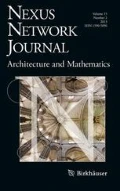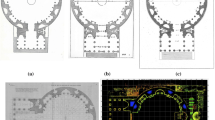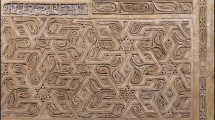Abstract
The drawing analysed in this article, conserved at the MNAC in Barcelona and attributed to the Spanish architect Diego Siloé (ca. 1490–1563), has never previously been studied in depth. It is a relatively rapidly executed sketch depicting a Renaissance urban setting, in which the authors not only demonstrate the sound use of one-point perspective, an extraordinary feat in Spain at that time, but also reconstruct it geometrically. Raking light photography provides a tool for identifying numerous incised lines, the true geometric support for the drawing, while a comparative analysis reveals a significant connection between the drawing and Siloé’s works, giving rise to new suppositions. The authors also detect a strong connection with Italy, consistent with existing hypotheses about the extent of the young Siloé’s Italian sojourn. The research conducted reinforces the attribution of the drawing to Siloé and opens up new channels for interpreting his life and work.





















Similar content being viewed by others
Notes
Inventory number: 107786-D. We are sincerely grateful to this institution and, in particular, to Francesc Quilez Corella, chief curator of drawings and prints, for allowing us to study and reproduce the drawing.
On palaeographic aspects, we are thankful for the advice of Pilar Ostos Salcedo and Carmen del Camino Martínez, professors of the University of Seville.
Gómez-Moreno (Gómez-Moreno 1983: 41) states that the master always wrote “Siloee”, with a double “e”, and also that the usual pronunciation would have put the stress on the “o”, as there are a diversity of ways in which hands other than the master spelled his last name. However, whether or not this last deduction is correct, the Flemish pronunciation of the term “Siloee” is equivalent in current Spanish to that of “Siloé”, with an accent on the last vowel, a form commonly used by many other researchers and shared by us. On the other hand, Gómez-Moreno also asserts that the preposition “de” placed between the first and last name (many researchers write “Diego de Siloé”) does not appear in the sixteenth-century documents, for either Diego or for his father Gil. Considering the unquestionable fact that the master himself always wrote with his hand “Diego Siloee”, we believe that the current equivalent form is “Diego Siloé”.
In the MNAC catalogue, the drawing is recorded as purchased in London in 1964 by Xavier de Salas Bosch, director of the Spanish Institute and secretary of the Board of Museums of Catalonia, possibly from an antique dealer. A reproduction of the payment can be found in Arxiu Nacional de Catalunya, ref. ANC1-715-T-6284.
The first important scenic apparatus, probably with a perspective set, was documented in 1548 (Ferrer 1991: 59ff., specially 75ff.).
An extremely low relief technique in which very shallow recesses create a sensation of depth.
It was sometimes difficult to distinguish them from the mark left by the pen on the paper. We overcame this difficulty by only validating as incised lines the ones that were visibly longer than the corresponding ink line. A certain number of incised lines have probably not been detected or preserved.
Approximate height of the eyes for a 6-foot statue, a classical reference used by Pedro Mexía in his Silva de varia lección published in Seville in 1540 (Sánchez 2012: 22).
References
Ampliato Briones, Antonio Luis. 1996. Muro, orden y espacio en la arquitectura del Renacimiento andaluz. Teoría y práctica en la obra de Diego Siloe, Andrés de Vandelvira y Hernán Ruiz II. Seville: Universidad de Sevilla y Consejería de Obras Públicas y Transportes.
Callejón Peláez, Antonio Luis. 2008. Primus inter heroes: damas y guerreros en la decoración del Monasterio de San Jerónimo. Granada: Mouliáa Map.
Carrer, Tomaso. 2007. The Triumphal Arch Motif in Sant’Andrea, Mantua: Respondeo and Rhetoric in Alberti’s Architecture and Theory. Dissertation submitted for the degree of Doctor of Philosophy at the University of New South Wales. Sydney: Kensington campus.
Davies, Paul. 2013. Framing the Miraculous: The Devotional Functions of Perspective in Italian Renaissance Tabernacle Design. Art History36(5): 898–921.
Domínguez Perela, Enrique. 1992. ¿La perspectiva en la pintura española el primer Renacimiento? Un problema sobre percepción de la profundidad. Arte, individuo y sociedad4: 195–204.
Falomir Faus, Miguel. 2000. Diego de Siloe. Perspectiva. In: Carolus, dir. Checa Fernando. Toledo.
Ferrer Valls, Teresa. 1991. La práctica escénica cortesana: de la época del emperador a la de Felipe III. Londres: Institució Valenciana d’Estudis i Investigació.
Frommel, Christoph Luitpold. 2008. Alberti e la porta triunfale di Castel Nuovo a Napoli. In: Annali di architettura: rivista del Centro Internazionale di Studi di Architettura Andrea Paladio20: 13–36.
Frommel, Sabine and Manuel Parada López de Corselas. 2014. Serlianas durante el Renacimiento italiano y español: del triunfo de la religión católica al lenguaje imperial. In: El Imperio y las hispanias: de Trajano a Carlos V, eds. De María Sandro and Parada López de Corselas Manuel, 287–318.
Gallego Burín, Antonio. 1936. Documentos relativos al entallador y vidriero Juan del Campo. In: Cuadernos de Arte de la Universidad de Granada1: 341–350.
Garriga Riera, Joaquím. 1988. Perspectiva. Obra atribuida a Diego de Siloé. In: L’època dels genis. Renaixement. Barroc, cat.65, 368. Gerona.
Gentil Baldrich, José María, 1998. El libro de perspectiva. In: Libro de Arquitectura: Hernán Ruiz II, 218–234. Seville: Fundación Sevillana de Electricidad.
Gómez-Moreno, Manuel. 1983. Las águilas del Renacimiento español (1941). Madrid: Xarait.
Gómez-Moreno, Manuel. 1988. Diego Siloe (1963). Granada: Universidad de Granada.
González Román, Carmen. 2006. “Los siete tratados de la perspectiva pratica”. La primera versión del libro de Antonio de Torreblanca. In: Boletín de la Real Academia de Bellas Artes de San Fernando102: 33–60.
Hara, Mari Yoko. 2016. Capturing eyes and moving souls: Peruzzi’s perspective set for La Calandria and the performative agency of architectural bodies. In: Renaissance Studies31 (IV): 586–607.
Hernández Redondo, José Ignacio. 2000. Diego Siloe, aprendiz destacado en el taller de Felipe Bigarny. In: Locus Amoenus5: 101–116.
Mediavilla, Aniano. 1979. Juan González y Juan García: entalladores de Santoyo. In: Publicaciones de la Institución Tello Téllez de Meneses43: 103–113.
Naldi, Riccardo. 2002. Andrea Ferucci. Marmi gentili tra la Toscana e Napoli. Naples: Electa.
Naldi, Riccardo. 2018. Magnificence of Marble: Bartolomé Ordóñez and Diego de Silóe, sculpture of the renaissance in Naples. Munich: Hirmer.
Nieto Alcaide, Víctor, 1967. Tres dibujos preparatorios para la vidriera de “La Crucifixión” de Walburg. In: Archivo Español de Arte164 (XLI): 267–274.
Nieto Alcaide Victor, 1973. Las vidrieras de la catedral de Granada. In: Corpus Vitrearum, Medii Aevi España, II. Granada: Universidad de Granada.
Ortega Vidal, Javier. 2001. Una muestra del dibujo de la arquitectura en la España Dorada. In: Las trazas de Juan de Herrera y sus seguidores, ed. López-Vidriero F.L., 337–416. Madrid: Fundación Marcelino Botín and Patrimonio Nacional.
Palladio, Andrea. 1980. I quattro libri dell’architecttura (1570). Milano: Edizione Il Polifilo.
Panofsky, Erwin. 1983. La perspectiva como forma simbólica (1927). Barcelona: Fabula Tusquets Editores.
Panofsky, Erwin. 1998. Los primitivos flamencos (1953). Madrid: Cátedra.
Parada López de Corselas, Manuel. 2018. La serliana del Palacio de Carlos V en Granada: arquitectura del poder entre España e Italia. In: El patio circular en la arquitectura del Renacimiento: de la casa de Mantegna al Palacio de Carlos V, eds. Pedro Antonio Galera Andreu and Sabine Frommel, 151–192. Seville: Universidad Internacional de Andalucía.
Pérez Sánchez, Alfonso. 1986. Historia del dibujo en España: de la Edad Media a Goya. Madrid: Cátedra.
Poggi, Paola M. 2005. Architectonica Perspectiva: La Prospettiva solida de Le Bacchidi e la volute. In: Baldassare Peruzzi 1481–1536, eds. Christoph L. Frommel, Arnaldo Bruschi, Howard Burns, Francesco Paolo Fiore and Pier Nicola Pagliara, 443–455. Venice: Marsilio.
Rosenthal, Earl. 1990. La Catedral de Granada: un estudio sobre el Renacimiento Español (1961). Granada: Universidad de Granada.
Sánchez Martín, Francisco Javier. 2012. La metrología renacentista: análisis científico y lexicográfico. In: Verba. Anuario galego de filoloxia39: 107–133.
Serlio, Sebastiano. 1537. Libro IV - Regole generali di architettura. In L’architettura: I libri I-VII e Extraordinario nelle prime edizioni. Milano: Edizioni il Polifilo.
Steadman, Philip. 2020. Baldassare Peruzzi and Theatrical Scenery in Accelerated Perspective. Nexus Network Journal 22(3). https://doi.org/10.1007/s00004-020-00479-z.
Tafuri, Manfredo. 1995. Sobre el Renacimiento: Príncipes, ciudades, arquitectos (1992). Madrid, Cátedra.
Toajas Roger, María Ángeles. 2007. Artistas hispanos en Italia en el siglo XVI: los viajes de Diego Siloe y Pedro Machuca. In: Viaje del Artista en La Edad Moderna, coords. Checa Cremades F. and González García J.L. Madrid: Editorial Complutense.
Vignola, Jacopo Barozzi da. 1985. Regla de los cinco órdenes de arquitectura (1562). Edición facsímil de la traducción castellana de 1593. Valencia: Ediciones Albatros.
Zurla, Michela, 2013. Domenico Fancelli, i re di Spagna e la congiuntura carrarese. In: Norma e capriccio: spagnoli in Italia agli esordi della maniera moderna, dirs. Mozzati Tomasso and Natali Antonio, 132–145. Firenze: Giunti.
Acknowledgements
All drawings and photographs presented in this article are by the authors, unless the opposite is specifically indicated. Antonio Ampliato was funded by HAR 2016-76371-P, Government of Spain, 2017–2019.
Author information
Authors and Affiliations
Corresponding author
Additional information
Publisher's Note
Springer Nature remains neutral with regard to jurisdictional claims in published maps and institutional affiliations.
About this article
Cite this article
Ampliato, A., Acosta, E. On the Use of Perspective in a Drawing Attributed to Diego Siloé. Nexus Netw J 22, 577–600 (2020). https://doi.org/10.1007/s00004-020-00487-z
Published:
Issue Date:
DOI: https://doi.org/10.1007/s00004-020-00487-z




